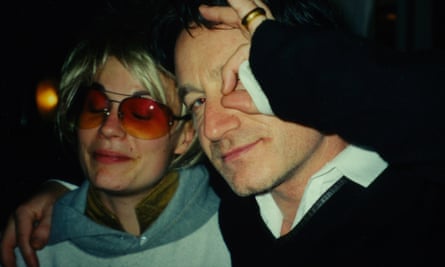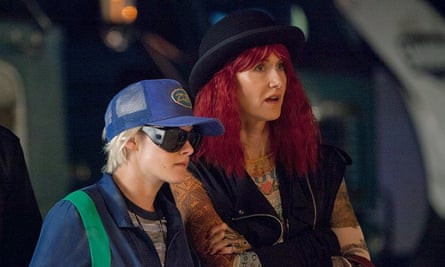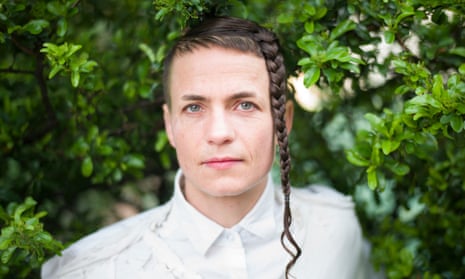Savannah Knoop and I meet up at a hotel in London – on April Fools’ Day, a date so ludicrously apt I can’t resist commenting on its suitability. “Oh yeah,” they say, with a slightly strained grin. (Knoop identifies as gender neutral and requests they/them pronouns.) Knoop believes what they did was not so much a prank as a performance: “Although someone recently described it to me as a caper. I liked that,” they say, making the rigid wide grin so familiar from the millions of photos of them, back from when the public knew them not as Knoop, but as the cult author JT LeRoy.
What Knoop and their then sister-in-law, Laura Albert, did is most commonly described as a hoax, or more specifically, “the greatest literary hoax of modern times”, to cite one headline. Back in the headily weird days of the late 90s and early 00s, when celebrities from different milieux mixed to such an extent that it was hard to distinguish between hype and hero, there was none as credible as Jeremiah Terminator LeRoy, the son of a truck-stop sex worker, who became an author and object of international fascination. Winona Ryder gushed about their friendship, Bono mentored him and Gus Van Sant wanted to work with him. Madonna wanted to convert him to Kabbalah and Garbage wrote a hit song about him. He was on the cover of Vanity Fair and every zeitgeisty figure of that era, from Liv Tyler to Courtney Love, spent hours talking on the phone to him, enthralled by his tales of sexual abuse. Asia Argento had an affair with him. Everyone wanted proximity to LeRoy’s edgy realness.

Alas, LeRoy did not exist. The books were written by Albert and Knoop was the public face, donning a ridiculous blond wig and large black sunglasses for appearances as LeRoy. Of the many writing hoaxes of that era, from James Frey’s drug addict “memoir” A Million Little Pieces to journalist frauds Jayson Blair and Stephen Glass, none was as bold or bizarre as LeRoy, and Albert and Knoop kept up the pretence for six years. During that time, LeRoy published a collection of short stories, The Heart Is Deceitful Above All Things, and bridged pop culture worlds from literary to fashion, from queer counterculture to mainstream acceptance. Albert and Knoop were finally exposed in 2006, and duly vilified. But in retrospect it was the celebrity acolytes and publishing insiders who were really made to look foolish. They prioritised a voyeuristic personal backstory over literary talent, valorising the work of two interesting but obviously vulnerable women only to drop it when they turned out to be less sexy than a former male prostitute.
The reason Knoop and I are talking today is because they, along with collaborator Justin Kelly, have written a movie about their experience. It stars Kristen Stewart as Knoop and Laura Dern as Albert, and is based on Knoop’s 2007 book Girl Boy Girl: How I Became JT LeRoy. It premiered in London the night before we meet, at Flare, the BFI’s LGBTQ+ film festival, and it is good, with Stewart capturing the young Knoop’s insecurity in their own identity and Dern nailing Albert’s captivating and manipulative charisma. But the movie underplays just how extraordinary their scam was. Courtney Love, still a good sport after all these years, appears in the film and Van Sant looked over an early draft of the script. But many of LeRoy’s former champions have stayed firmly away. The 2016 documentary Author: The JT LeRoy Story, which is told by Laura Albert, gives a better sense of the scale of the hoax, but Knoop’s version is more heartfelt and less self-justifying, exploring the conflicted youthful sexual and gender politics behind the whole farrago.

Knoop, 38, is warm and friendly, but it is undeniably odd talking to someone whose face is so familiar – the bottom half of their face, that is. The square jaw, postbox-like smile and small nose are all recognisable from the photos of LeRoy. The rest, however, is very much Knoop 2019: their hair is undercut around the sides and the top is woven into a long plait. Knoop is now an artist and worked as a fashion designer. “This is a knockoff of my favourite collared shirt,” they say pointing to the starchy button-down white shirt that is largely obscured by a large rag wrapped around their body. “Yes, my sweetheart and I collect rags. And I’m wearing Spandex underneath, as always,” they add, pointing to the silver sleeves covering the bottom half of their arms. Their long leather skirt is a repurposed trenchcoat. “It’s hard to find a silhouette I like, a good straight-down skirt,” they say.
Knoop is very precise about what they like and dislike, and where their boundaries lie. They reject two cafes until we find one that they – rightly – think is better. When the film’s PR representative appears, they tell her in no uncertain terms to not sit with us but to wait somewhere else. And when I occasionally garble my gender-neutral pronouns, they kindly but firmly correct me.
“I think my experience [as LeRoy] helped me to dismantle the ways we’re supposed to be and to keep questioning how something feels, which parts matter to me,” they say.
Few people have embodied the slipperiness of gender as much as Knoop, born female but best known for playing a boy. But unlike Albert, who had been pretending to be a boy when talking on the phone for years, Knoop didn’t grow up with any gender confusion. “But I think [my gender neutrality] was always there, and JT helped to articulate it for me,” they say.

Albert recruited Knoop to play LeRoy when her book, Sarah, which was the story of LeRoy’s sex worker mother, became so successful that she needed someone to play him in public. Knoop, the teenage sibling of Albert’s then husband Geoff, had an androgynous look that fitted the bill.
In both Knoop and Albert’s films, it is clear that Albert quickly became jealous of the attention received by Knoop, who was embraced by celebrities while Albert – by this point playing, for no reason, LeRoy’s friend Speedie, with a ludicrous British accent – was elbowed out of the way. Albert was talented (the LeRoy books, while absurdly overheated, stand up surprisingly well) but things became increasingly complicated between her and Knoop and once the whole enterprise came crashing down, the two went through “something like a breakup”. When Knoop later told her they were writing a book about their experience, Albert, according to Knoop, sniped: “Just because you played a writer doesn’t mean you are one.”
Are the two of them in touch now? “We are a little bit, kinda, through email,” Knoop says. I ask if they feel anger at Albert for taking advantage of them when they were so young. “I don’t, but I think it’s important to take responsibility for one’s actions.” And they feel Albert hasn’t? “I’m just going to leave that there,” they say with a smile.
Knoop is depicted in the film as an insecure, confused teenager who clung to, and was exploited by, two women: first Albert, then Asia Argento, renamed Eva in the movie (and played by Diane Kruger) and renationalised as French instead of Italian. The story of LeRoy’s affair with Argento has always been presented as a weird but minor detail in the saga, but Knoop’s movie makes it the heart. Knoop is depicted in the film as really falling for Argento, and it’s heavily implied that Argento always knew Knoop was female, which answers the long-running question of how Argento could have allegedly had a physical relationship with LeRoy and not known the truth. In the film, Knoop accuses Eva of seducing them purely to get the film rights to The Heart Is Deceitful Above All Things – which Argento directed, co-wrote and starred in – and it’s never entirely clear whether they are right.
Has Knoop been in touch with Argento since the truth came out? “No, no. Well, I wrote to her but I didn’t hear back,” says Knoop with a shrug.

With its explorations of identity and gender, its questioning of whether personality matters more than talent, the JT LeRoy story feels even more relevant today than it did 13 years ago. Yet it also feels quaint, overtaken by bigger stories that, in fact, started to emerge through it.
In the 2016 documentary, Argento is shown at the Cannes premiere of The Heart Is Deceitful Above All Things alongside none other than Harvey Weinstein, who Argento has since accused of rape (he denies any non-consensual sex). As if there wasn’t enough queasy weirdness in this saga, the child actor who plays Jeremiah in Argento’s film was Jimmy Bennett, who last year accused Argento of sexually assaulting him when he was a minor. (She has claimed he sexually assaulted her.) At the time, the LeRoy story seemed like the ultimate satire on the celebrity world’s shallow, exploitative nature. But in truth, it barely scratched the surface.
“Yeah, weird timing [with the movie’s release], right?” says Knoop, re-establishing their boundaries by shutting down.
When Albert and Knoop were finally exposed, the latter felt mainly relieved. “But then [our intentions] were misunderstood, and it’s a terrible thing to not be understood. It’s like not being seen,” they say. This is why they’re still telling their story, 20 years after it began, to clarify their side and their identity.
But as usual, things aren’t that simple. Knoop recently launched their website to showcase their art, so people can see they’re more than LeRoy. Unfortunately, it’s pretty hard to find: “I haven’t figured out how to do the search engine optimisation, so it doesn’t really show up,” they shrug. Because, of course, when people google Knoop’s name, they only find articles about LeRoy. After all this time, it is still hard for Knoop to be seen.

Comments (…)
Sign in or create your Guardian account to join the discussion